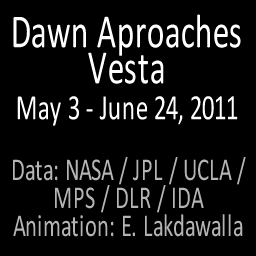Emily Lakdawalla • Feb 14, 2012
Dawn images of Vesta! Released!! For everyone!!!
Can you tell I'm a little bit excited about this? Some time in the last few days, the Dawn team made public the first preliminary version of the first release of their data from the Vesta phase of their mission. This is soooo much sooner than I had understood that this data release would happen. It's only been nine months since the ion-powered Dawn spacecraft began its exploration of a never-before-visited world. Vesta is the second largest asteroid, about 550 kilometers across. It's similar in size to Saturn's moons Mimas and Enceladus, but an utterly different place. Before Dawn, it was not much more than a smudgy spot of light. Now, it's a new world, still being explored by Dawn as it orbits only 200-ish kilometers above the surface.
Only nine months since their approach phase started; this first public release of scientific data covers their entire cruise to Vesta as well as the Approach and Survey phases of the mission, up through August 30, fewer than six months ago. That's a shorter proprietary period than Cassini! W00t!
I've downloaded all the Framing Camera data, and there are thousands and thousands of images. It's going to take me a while to wrap my head around all of it. But I didn't want to wait to post a little something from this data set. To put the images below into context, though, I really encourage you to go back and read what I posted on June 3, 2011 about why I was incredibly disappointed in the Dawn image release policy, and what the Principal Investigator had to say about that. Among other things, I said the following:
One month ago, Dawn began its Approach Phase, the first phase in its science mission to Vesta. Its first image of Vesta showed little more than a bright dot among background stars, but it was thrilling nonetheless. I couldn't wait to watch with the science team as they homed in on that dot. At first, throughout May, it would remain little more than a bright dot, but one that moved with respect to background stars, its motion telling how near Dawn was to it. This month, I expected to begin to see it spread as a few pixels across the sky, some darker, some brighter, the darker and brighter pixels impossible to correlate from one image to the next, but still offering enticing clues at variations on Vesta's surface that Dawn would soon be able to map. Later this month, there would be more pixels across Vesta than we have managed to see in Hubble photos; with Dawn's exquisitely slow approach I anticipated the stretching-out of that feeling of discovery of a new place, as Vesta came ever so slowly into focus, week by passing week.
That didn't happen, and we were all robbed of the experience of seeing this new world slowly shift into focus.
Well, here's that period of the mission that I had been so eagerly anticipating, represented in a montage of representative photos, and below that, in an animation.

The first image is just a slightly misshapen dot. By the fourth or fifth, the shape is beginning to be defined. By the sixth photo, June 8, there is the first hint of an indentation marking a large crater. The seventh photo I think shows the first clear evidence of albedo variety, in the form of a teeny bright dot at the lower right limb. In the eighth I can definitely see a couple of craters. The next two bring new details into focus.
Oh, but it gets better. During that span of time, Dawn didn't just take ten pictures; there were actually close to 400. Of these, half were overexposed, a necessity for Dawn's cameras to see faint background stars to aid in optical navigation. But in the other half -- well, see for yourself.

It's just what I imagined. At first, just a dot, weaving a bit in Dawn's vision as it acquires its target against the background of stars (too faint to be seen in these images). Then you get a hint of motion other than Dawn's. You realize Vesta is spinning, and which way it's spinning. You start to see features moving with rotation. Then craters. The seven weeks comprising this animation embody the slow-motion transformation of Vesta from a fuzzy dot of light to a world with unexplored geology -- mountains and craters and days and nights. I am still sad that I missed the opportunity to feel the buildup of anticipation of what each week's new image would reveal, the excitement of new detail, and the frustration of it never being quite enough. But I do feel a little bit of that thrill, watching this animation again and again. This is just a tiny taste. The data release includes images taken from much closer, when Vesta filled Dawn's camera frame three times over. To have all the data -- thousands and thousands of images -- so quickly -- well, it's fantastic. I don't know what the future data release calendar is, but for now, you can color me mollified.
What comes next? Stay tuned -- you can bet I'll be digging out a lot more Dawn data in the coming days.
One last note. The release didn't just include Framing Camera data; it also included data from Dawn's other two instruments, an imaging spectrometer and a neutron detector. I will definitely not have time to dig in to either one of these data sets. I hope that someone else will!
The Time is Now.
As a Planetary Defender, you’re part of our mission to decrease the risk of Earth being hit by an asteroid or comet.
Donate Today

 Explore Worlds
Explore Worlds Find Life
Find Life Defend Earth
Defend Earth


